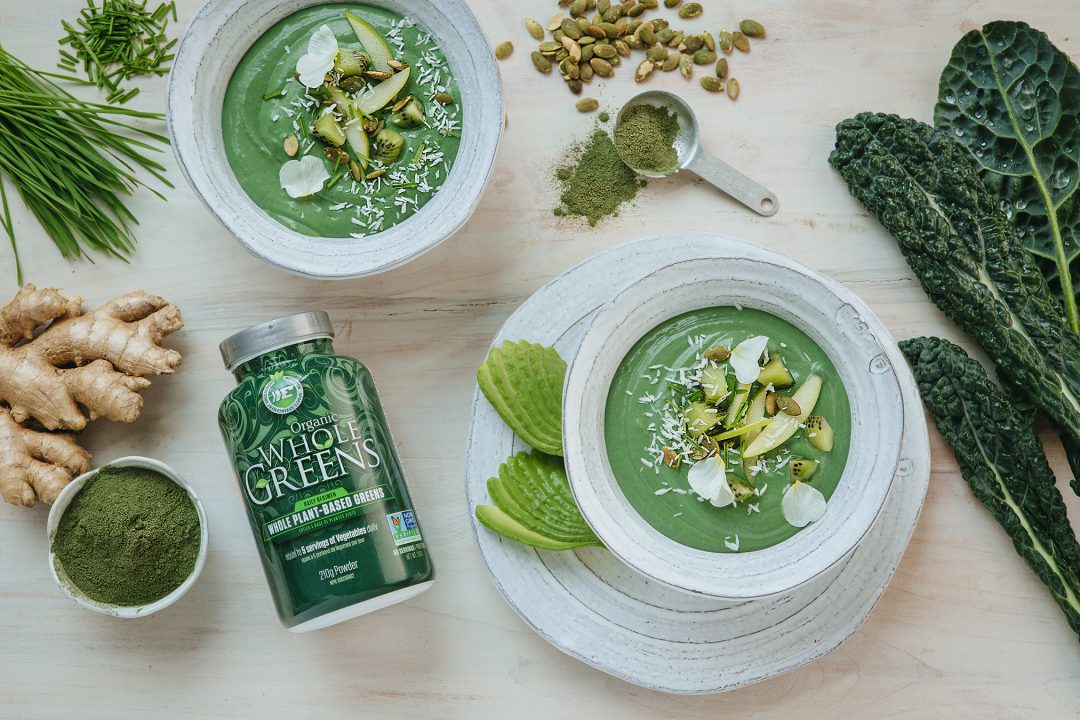Add These Green Super Powders to Your Meals for a Healthy Boost
2017 Sep 1st - by
Long gone are the days when eating kale felt trendy or exotic. Now there are more unusual ways to eat your healthy greens, such as spirulina, moringa, chlorella, matcha, and wheatgrass, many of which come in powder form and can be found in Ergogenics Organic Whole Greens. These superpowered green powders are really easy to add to your diet. Toss ’em into a smoothie or your morning oatmeal or even a glass of water if you dare.
Spirulina
You may have spotted spirulina, which is a type of freshwater algae, on the ingredients list of your Whole Foods energy bars. But you can also take advantage of the numerous health benefits by going straight to the powder version. Just be sure to consult your doctor if you’re taking an anticoagulant, antiplatelet, or immunosuppressant medication. Spirulina can sometimes mess with those, says Alexandra Miller, R.D.N., L.D.N., a dietitian.
Why it’s awesome: A 2-teaspoon serving has 15 calories and 3 grams of protein, which is pretty huge when you consider an egg has 6 grams. Spirulina is also “an excellent source of copper and a good source of thiamin, riboflavin, and iron,” says Miller. Some studies have shown spirulina is packed with anti-inflammatory properties, immunity benefits, and the antioxidant beta-carotene, though Miller says more research is needed before you can be sure. It is known, however, that spirulina can boost exercise endurance, according to a study from Taiwanese researchers, and can help lessen the stuffy noses that go along with allergies, most likely because of spirulina’s ability to fight inflammation.
How to use it: In a smoothie, juice, or baked goods.
Chlorella
Like spirulina, chlorella comes from a strain of blue-green algae. It’s similar to spirulina in its nutritional profile, too, and has comparable amounts of protein, vitamins, and antioxidants, says Miller.
Why it’s awesome: Chlorella’s lutein components help protect the eyes, and its beta-carotene has been shown to protect against cardiovascular disease. Chlorella’s biggest claim to fame, though, is that it’s rich in B12, an essential vitamin that many vegetarians don’t get enough of since it’s most commonly found in animal sources. A 2015 study published in the Journal of Medicinal Food asked participants with a B12 deficiency to take 9 grams of chlorella a day. After two months, their B12 levels increased by an average of 21 percent. What’s more, research published in Nutrition Journal found taking in half of that—5 grams a day—is enough to lower cholesterol and triglyceride levels.
How to use it: Toss 1 teaspoon of the powder into your smoothie, chia seed pudding, or nut milk.
Matcha
When green tea leaves are dried and ground into a very fine powder, you end up with matcha. That means matcha offers a pure and super-concentrated dose of green tea’s phytochemicals.
Why it’s awesome: Matcha is great for the same reasons that green tea is—it can lower cholesterol, blood glucose, and triglyceride levels, according to a study published in Food & Function. “Epigallocatechin gallate (EGCG), a polyphenol known for its potential anti-cancer and antiviral properties, is at least three times higher in matcha than other green teas,” says Miller. A new study published in the journal Current Pharmaceutical Design dug into matcha’s reputation for boosting your mood and brain power. After reviewing 49 studies, the researchers cited the combination of caffeine, which delivers a kick in alertness, and L-theanine, an amino acid that promotes relaxation and calmness, was particularly useful in helping people switch from task to task without distraction.
How to use it: Drink it up in a latte or add it to smoothies.
Moringa
This super powder is the result of grinding up the leaves and seeds of a plant called moringa oleifera.
Why it’s awesome: There’s no question that moringa qualifies as a superfood thanks to its high counts of vitamin C, vitamin A, calcium, iron, protein, and antioxidants. But since you’ll likely only have 1 or 2 teaspoons per serving, moringa alone won’t exactly guarantee you’ll meet your recommended daily allowance of those nutrients (though your vitamin C levels will get close). Still, it’s better than nothing, and moringa can be particularly helpful for people with diabetes, according to a study published in Phytotherapy Research.
How to use it: Like other green powders, moringa is a great addition to smoothies, oatmeal, and granola bars.
Wheatgrass
You probably first encountered wheatgrass in the form of green shots. The grass comes from the wheat plant Triticum aestivum, and a paper published in Food Science and Quality Management summed it up best by saying that it’s “a humble weed that is a powerhouse of nutrients and vitamins for the human body.” We’ll drink to that.
Why it’s awesome: According to Israeli researchers, wheatgrass is rich in chlorophyll, flavonoids, vitamin C, and vitamin E. In their study published in Mini Reviews in Medicinal Chemistry, they report that wheatgrass has been shown to have anti-cancer potential, possibly because of its apigenin content, which prevents cellular damage. A few small studies also found it could lessen the effects of health issues such as diabetes, obesity, and rheumatoid arthritis.
How to use it in food: Blend 1 teaspoon into a fruit juice or a smoothie.

